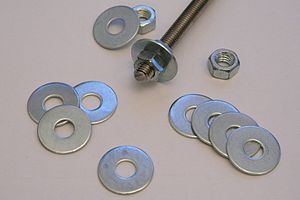Washer
Washers , washers or washers are ring-shaped washers that can be slipped over the shaft of a screw and are mostly made of metal . "Enclosed" between the screw head and the part to be fastened with the screw, it serves to transfer the force emanating from the underside of the screw head to a larger area of this part, the material of which is usually less firm than that of the screw. For through metal screws, a washer is also placed under the nut . Washers come in different sizes and with different sizes. A washer is not required for special screws with a larger round head.
Because of its larger diameter, the washer remains on the part to be fastened when the screw or nut is tightened. The sliding takes place between it and the screw head or nut, and the surface of the part cannot be damaged by rubbing .
The same standardized washers can also be used for screws that are not tightened and that serve as axes for simple swivel joints . They are not loaded axially, but guarantee a better concern than z. B. the angular underside of a hexagonal screw head. In simple cases, a nut is dispensed with or the screw is replaced by a pin, with the washers being prevented from slipping by means of split pins or the like.
function
In the case of soft materials (e.g. wood ), washers have the task of preventing the surface of the soft material from tearing out when tightened. If a disk larger in diameter than the tip circle itself has sufficient flexural strength , the surface pressure can be reduced. In summary, washers reduce the sinking or digging of the screw head into the soft material.
Dimensions
- Washers for metal connections have - apart from small washers - an outside diameter of about 1.8 to 2 times the bore diameter.
- In the case of washers for wood connections ( DIN 440 , ISO 7093), the outside and bore diameters are in a ratio of around 3: 1.
Executions
- Preferably for hexagon bolts and nuts
- Washers, outside diameter about 2 × hole diameter according to ISO 7092 (formerly DIN 433)
- Washers, outside diameter about 3 × hole diameter according to ISO 7093 (DIN 9021)
- Washers for steel structures according to DIN 7989-1 (product class C) or DIN 7989-2 (product class A)
- Square washers according to DIN 434 (slope 8%) and DIN 435 (slope 14%) for U and I beams ( profile steel )
- Square washers for wood connections according to DIN 436
- Washers for wood connections according to DIN 440 with round (R) or square inner hole (V)
Special forms
- There are also company standards and special designs for washers.
- Body washer or fender washer (formerly DIN 9022): Extra wide washer for mounting on (thin) sheet metal.
- Fitschenring : Washer adapted to the diameter of a mandrel in door hinges ("door hinge") and the outside diameter.
- Shim washers are available in various thicknesses and are used to set a certain distance, e.g. B. the axial play in motor shafts.
- Spherical washers (DIN 6319C) enable tilting in conjunction with tapered sockets (DIN 6319D), whereby a line contact is maintained between the components.
- Lock washer : secures nut
- conical washer ( rosette ) under countersunk head screws
Spring washers
Spring washers are not counted among the washers, as their function is more to secure the screws . See also: serrated lock washer , tooth lock washer , Schnorr washer , spring washer . Basically, appropriately designed screw connections do not need any resilient washers. The common method is to maintain the minimum clamping length , which can be appropriately increased using pieces of pipe or spacer sleeves instead of washers.
Remarks
- ↑ A screw used as a rotation axis should anyway have a longer thread-free shaft on which the radial bearing forces are transmitted.

